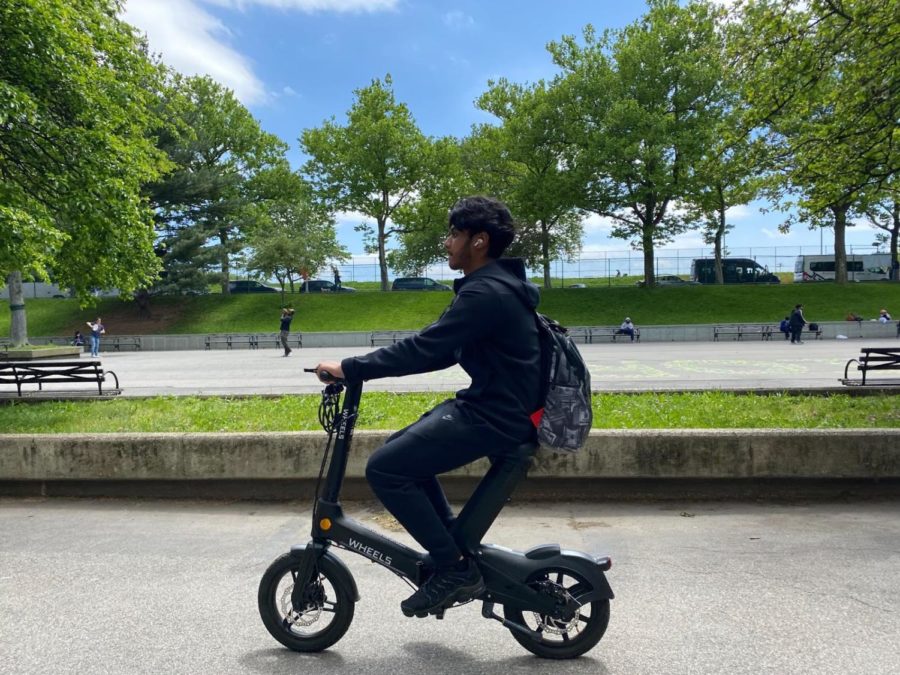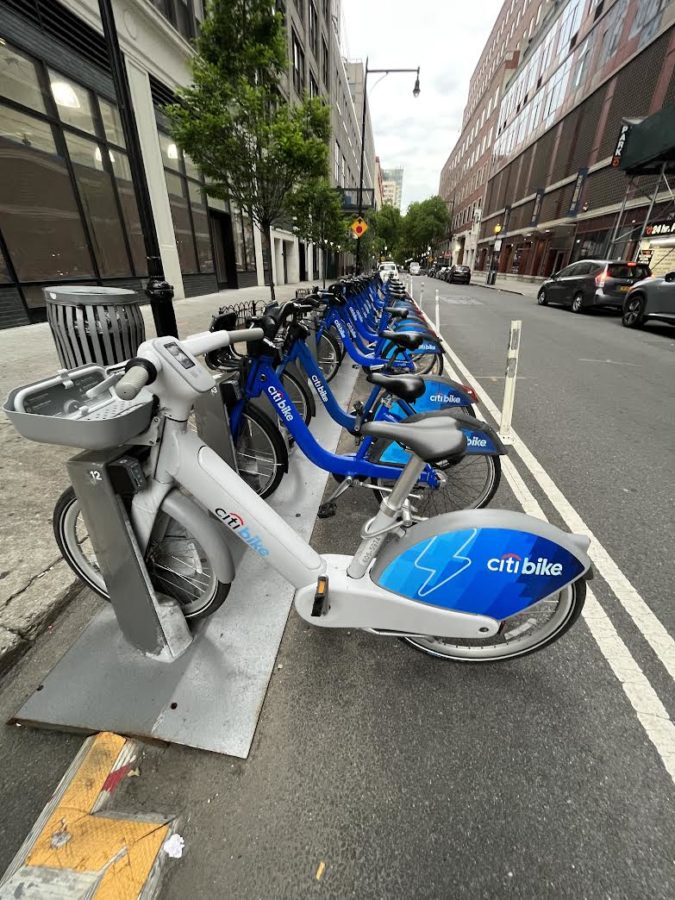Electric Bikes are Here to Stay
New York City has had a long battle with electric bikes, but now they have become a staple of the New Yorker commute.
Mohammad Akonda ’22 rides his electric bike around the Bronx Science courtyard before he prepares to bike home.
The hum of electric bikes is not new to New York City. Residents might recognize the buzz of makeshift electric delivery bikes with motors attached from years prior, but this year, the noise is deafening. Over 800,000 New Yorkers ride bicycles, and the city is becoming more and more welcoming towards them. Since the start of the Coronavirus pandemic in March 2020, participation in Citi Bike, a bicycle ride sharing program, in New York City has increased by 39%. Though the city has a long and complicated relationship with electric bikes, they are here to stay and already dominate the streets.
For Jacob Sak ’22, Citi Bike is one of his main forms of transportation aside from the subway. “I use a Citi Bike at least once a day,” said Sak. “Nothing can beat the speed and convenience of an electric Citi Bike, and once I started using the electric bikes, I was hooked, and now I almost rarely use a non-electric bike.” Citi Bike, operated by Lyft, is the largest bike ride share program in the city and has nearly 5,000 electric bikes in its expansive 24,500 fleet of bikes. These bikes are stationed at 1,500 different locations throughout New York City.
However, of the nearly 30,000 bikes that Lyft provides, the electric bikes are three times more likely to be used than the normal Citi Bikes. According to the 2022 Lyft Multimodal Report, these electric bikes made up a striking 13.6 million of the 28 million rides taken by Citi Bike users in 2021. Sak resides in Brooklyn, and while he does not use Citi Bike to travel between boroughs, he almost always uses a bike to travel within Brooklyn. “Citi Bike has made my commutes much easier,” asserts Sak.
In the first week of May 2022, Citi Bike released a newer model of their electric bike in New York City. Sak is among more than 169,000 Citi Bike users with an annual membership that allows him first access to the newer bikes. The bike has a battery that lasts 60 miles which is a 20% increase in speed from the older model, an LCD screen with instructions to unlock it, and a new design that incorporates more comfort for the rider. New safety features such as on-board safety sensors and hydraulic brakes were also added, neither of which were features on the older electric bike. Citi Bike members are still the only people with access to the new bikes, though the bikes may encourage more people to sign up for the $15.42 monthly membership. And with new attention drawn to Citi Bikes, many more people will soon be able to join Sak and other riders and rent Citi Bikes.
The accessibility of Citi Bike is set to expand as New York City enters the third phase of the NYC Streets Plan. This phase plans to widen the scope of Citi Bike to 70 square miles, across four boroughs. It is expected to be completed by 2024 and create a massive system of over 40,000 bikes. By the end of this phase, it is expected that 50% of New Yorkers will be within a five minute walk to their nearest Citi Bike station. Increased accessibility matches the increased demand for micro mobility options, especially after the pandemic and concern over public transportation.
Still, of the new bikes, electric options are limited in growth due to growing fears of electric bikes on the road. A cap on the number of electric Citi Bikes allowed on the streets was put in place by the Department of Transit (DOT) and keeps the number of electric Citi Bikes to only 20% of the entire fleet. However, because electric bikes are three times more likely to be used than the non-electric bikes, Borough Presidents of Manhattan and Brooklyn urged the DOT to raise the cap, as they believe it is better to facilitate and encourage riding any type of bike got New Yorkers.
Outside of Citi Bike, new advancements and upgrades to E-bikes have incentivized New Yorkers to purchase or rent electric bikes for themselves. Companies such as Aventon, Chartior, RadWagon, Rattan, and Jupiter are just a few of the popular electric bicycle brands on the market. At Bronx Science, graduated senior Mohammad Akonda ’22 used an electric bike that he rented monthly from Wheels.co to bike to school every morning. The bike is fully electric and travels up to 18 miles per hour. “Riding to school was more efficient and much faster than a regular bike,” said Akonda. The journey from home took him only 20 minutes, compared to an hour-long bus ride. In his free time, Akonda could be seen riding around the courtyard listening to music.
The use of electric bikes does not stop there. Even Ecargo bikes, capable of carrying heavy loads and even children have become popular amongst New Yorkers. Kendra Hurley of the New York Times interviewed families that use E-bikes specifically with room on the back for a car seat as a means of taking their children to school, and many praised these electric bikes for their convenience. These electric cargo bikes have replaced taking the subway for many families. Chris Nolte, owner of Propel Bikes in Brooklyn, a shop that carries electric cargo bikes, said that “Biking as family transportation has become a lot more mainstream.”
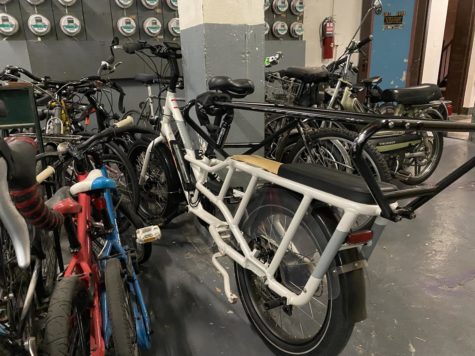
However, this boom in the world of electric bikes would not have been possible five years ago, much less three. After a tough journey towards legalization that was fraught with challenge – Governor Cuomo vetoed a bill that would have legalized electric scooters and bicycles in New York in 2019 – electric bikes finally became authorized in 2020. The response to Cuomo’s initial stance on electric bikes, mainly used by delivery personnel in 2020, was focused on the impact this would have on the workers in the field that needed these bikes. Ed Shanahan of the New York Times interviewed Danny Harris, the executive director of Transportation Alternatives; his company advocates for reclaiming New York City streets for pedestrians and bikers. Harris commented that Cuomo’s veto of electric bikes “has failed to protect 40,000 low-wage, mostly immigrant workers in New York.” The veto unfairly impacted workers who relied on electric bikes for their job.
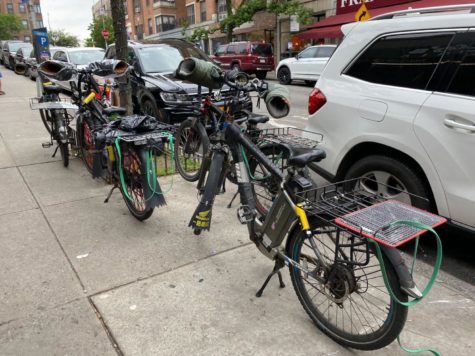
The battle towards legalizing electric bikes was long fought in the city and action against electric bikes was taken by Former Mayor Bill De Blasio. In early 2020, De Blasio cited the danger of electric bikes in the streets and discussed the crackdown on the bikes, referencing the more than 1,140 summons issued by the New York Police Department for electric bikes in 2019. These summons resulted in the confiscation of the electric bike and a $500 fine. So, how did New York City progress from severe opposition to electric bikes now flooding the streets?
As the Coronavirus spread in New York City in January of 2020, delivery personnel became frontline workers coming in contact with sick New Yorkers, and De Blasio was forced to change his stance and pause the crackdown on electric bikes, which ultimately allowed workers to work more efficiently. In June of the same year, the New York City Council legalized electric bikes and scooters for use in the city.
However, this transition to legalization has faced many bumps in the road. For example, in many New York City parks, such as the Hudson River Greenway, it remains illegal to take an electric bike onto the bike path or other roads. Many still frown upon electric bikes over safety concerns because of the bikes’ faster speed. Nonetheless, other strides have been made to accommodate for this influx of bikers and particularly electric bikers; the surge in electric bikes and biking is not random.
Since 2019, a sweeping majority of the legislature has turned in favor of electric biking, and recent policy and implementation of city planning has also done much to encourage the use of electric bikes and biking as a mode of transportation. Current Mayor Eric Adams has proposed a $904 million dollar plan set to expand on the NYC Streets Plan, the DOT’s five year plan to improve the streets and transportation in New York City. The NYC Streets Plan, created in 2021, has many goals set to be implemented this year, including a proposed 30 miles of Protected Bike Lanes and a new wide “bike boulevard” in each borough. The target goals for biking growth are that by 2050 one in ten trips will be made by bike and that each year bike lanes will expand by 30 miles. The plan designates certain areas as Bicycle Priority Districts which will have 75 miles of infrastructure, as opposed to 30 miles, added to accommodate biking in the area by 2022. Lastly, Adam’s further commitment to this plan by adding an extension to add 10,000 bike parking racks around the city, has tripled the amount initially proposed, thereby making the city more bike friendly.
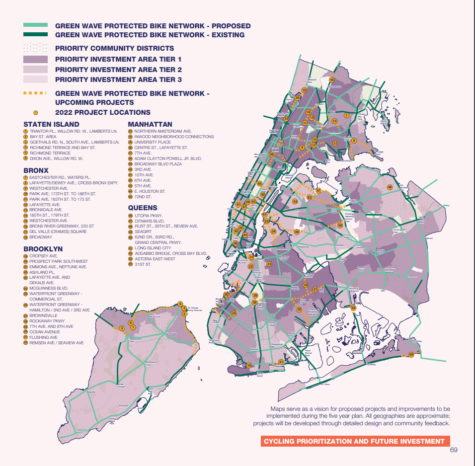
Ms. Gail Jaitin, an English teacher at Bronx Science, bikes to school almost every day, in rain or shine, summer or winter. Inspired by a blog post by Mr. Money Mustache that highlighted how biking is financially responsible as well as environmentally conscious, Ms. Jaitin began biking. She hopes to be more environmentally friendly with her commute that she would otherwise drive daily.
While Ms. Jaitin was able to extol the many benefits of biking, praising its help with her sleep patterns, its ability to tire her out and provide the opportunity to exercise, she doubled down on how the Bronx lacks the framework for biking. “I wish that there was more infrastructure in the Bronx; that is something that is really difficult because cars can be kind of scary.” Ms. Jaitin has been riding her bike for six years and has yet to witness much change in the accommodations made for bikers in the streets.
The biggest bike lane near Ms. Jaitin, running along Broadway near Van Cortlandt Park, is not one that is convenient to her daily commute, so she bikes on the street or on small bike paths. Her current ride to school takes about 25 minutes, and although an electric bike would make her trek across avenues much more speedy, she is unable to ride one. Since there are no Citi Bikes available in Ms. Jaitin’s neighborhood and personal electric bikes are too expensive, she cannot shorten her commute. “I long for the day when there are more protected bike lanes,” said Ms. Jaitin.
Despite drastically increased ridership of bikes on the streets, New York has yet to update safety measures and make the city more accommodating for bike riders. In 2019, deaths of cyclists reached historic highs, and 2022 is on track to surpass these statistics. According to the organization Transportation Alternatives, within the first three months of 2022 alone, traffic fatalities had increased by 44%. The streets are becoming more dangerous, and with more bikes entering the scene, the implementation of the city’s commitment to adding more biking infrastructure could not come at a better time. Safer roads and more accessible bike paths are needed and are coming soon to New York City. Bikers, pedestrians, as well as their new companions, electric bikes, will dominate the streets in the coming months.
“I long for the day when there are more protected bike lanes,” said Ms. Gail Jaitin, English teacher at Bronx Science.
Nora Maher is a Staff Photographer and People Section Editor for ‘The Observatory’ yearbook. She loves the creativity involved in taking photographs....

